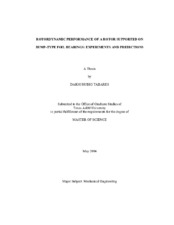| dc.description.abstract | Gas foil bearings (GFB) appear to satisfy most requirements for oil-free
turbomachinery, i.e. relatively simple in construction, ensuring low drag friction and
reliable high speed operation. However, GFBs have a limited load capacity and minimal
amounts of damping. A test rig for the rotordynamic evaluation of gas foil bearings was
constructed. A DC router motor, 25 krpm max speed, drives a 1.02 kg hollow rotor
supported on two bump-type foil gas bearings (L = D = 38.10 mm). Measurements of
the test rotor dynamic response were conducted for increasing mass imbalance
conditions. Typical waterfalls of rotor coast down response from 25 krpm to rest
evidence the onset and disappearance of severe subsynchronous motions with whirl
frequencies at ~ 50% of rotor speed, roughly coinciding with the (rigid mode) natural
frequencies of the rotor-bearing system. The amplitudes of motion, synchronous and
subsynchronous, increase (non) linearly with respect to the imbalance displacements.
The rotor motions are rather large; yet, the foil bearings, by virtue of their inherent
flexibility, prevented the catastrophic failure of the test rotor. Tests at the top shaft speed,
25 krpm, did not excite subsynchronous motions. In the experiments, the
subsynchronous motion speed range is well confined to shaft speeds ranging from 22
krpm to 12 krpm. The experimental results show the severity of subsynchronous motions
is related to the amount of imbalance in the rotor. Surprisingly enough, external air
pressurization on one side of the foil bearings acted to reduce the amplitudes of motion
while the rotor crossed its critical speeds. An air-film hovering effect may have
enhanced the sliding of the bumps thus increasing the bearingsÂ’ damping action. The
tests also demonstrate that increasing the gas feed pressure ameliorates the amplitudes of subsynchronous motions due to the axial flow retarding the circumferential flow velocity
development. A finite element rotordynamic analysis models the test rotor and uses
predicted bearing force coefficients from the static equilibrium GFB load analysis. The
rotordynamic analysis predicts critical speeds at ~8 krpm and ~9 krpm, which correlate
well with test critical speeds. Predictions of rotordynamic stability are calculated for the
test speed range (0 to 25 krpm), showing unstable operation for the rotor/bearing system
starting at 12 krpm and higher. Predictions and experimental results show good
agreement in terms of critical speed correlation, and moderate displacement amplitude
discrepancies for some imbalance conditions. Post-test inspection of the rotor evidenced
sustained wear at the locations in contact with the bearings' axial edges. However, the
foil bearings are almost in pristine condition; except for top foil coating wear at the
bearing edges and along the direction of applied static load. | en |


